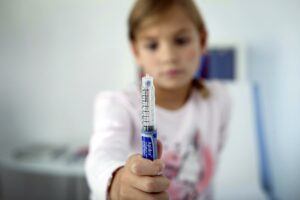In 2017, a report generated by the National Institute of Health reported that about 2,08,000 children (adolescents under the age of 20) suffered either Type 1 or Type 2 diabetes within the United States. The report also stated that the prevalence of Type 1 diabetes was increasing by 1.8% and Type 2 by 4.8% a year.
These statistics alone show that diabetes doesn’t just affect older people but kids and young adults as well.

If your toddler has been suffering from any (Type 1 or Type 2) diabetes, here are some basic measures to manage the disease:
Take prescribed Insulin:
If a toddler is suffering from Type 1 diabetes, it is important to balance the blood sugar levels in their body. Insulin helps to let the patient metabolize glucose present in their blood for energy.

Make sure you are not giving their insulin dose via pill as it is hard to absorb. In addition to this, the digestive juices and acid in the stomach can break the insulin pills before it could release its beneficiary elements.
Monitor Blood Sugar Levels:
As a parent, you have to check the blood sugar levels of your little one on a daily basis. If controlled at the right age, it helps to avoid many diabetes complications until the late 40s. There are many practitioners who consider using CGM (continuous glucose monitor) which comes as a wearable gadget and an excellent choice to keep a track of blood sugar levels.

If you don’t want to go for CGM, look for another blood test named ‘glycosylated haemoglobin test.
Be Concerned About Exercises:
No matter what age or health issue you are going through, mild exercising on a daily basis is a must. Exercising becomes more prominent in importance when a child is going through diabetes. In this scenario, the main objective of exercising includes maintaining average body weight, keeping blood pressure and cholesterol levels under control, as well as maintaining lung, heart, and blood vessel health.

All types of exercises from a brisk walk or bike ride to climbing rocks are ideal for the patient.
Go Digital:
Medicine intake fastens the recovery process (when done as prescribed by a doctor). If your child is prescribed medications to manage their disease, make sure you go for installing a medication tracker app like MedManage that reminds the user and keeps track of medication intake via smart notifications. Such convenient tools don’t just remind your toddler to take their medicines on time but also encourages and reinforces the habit of staying on top of their health. The MedManage app also provides information about the drugs being taken, clearly shows the directions, and has a medication intake log which can be shown to your doctor. The best part is the app is available for free on apple, android, and web for up to 2 profiles.
Balanced Diet:
This one is perhaps the most important factor to take care of. Understand and encourage a balanced diet for your child while paying special attention to the intake of carbohydrates as it can lead to blood sugar level fluctuations. Go for meals including fish, pork, seafood, eggs, tofu, cheese, beans, nuts, avocados, sliced apples with peanut butter, or turkey which have lower affects on diabetics.
Whether it is a diabetes drugs list or diet plan that you are wondering about for your child, make sure to consult with your doctor before making any decisions on your own.

